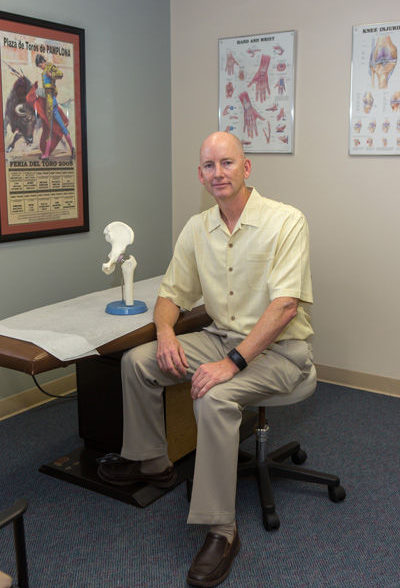
It’s virtually impossible to spend any time in Vero Beach without meeting someone who has had knee replacement surgery.
That’s not surprising. After all, the Centers for Disease Control and Prevention projects that 719,000 knees will be surgically replaced in the U.S. this year alone. The American Academy of Orthopedic Surgeons says within the decade, knee replacements will exceed three million annually.
What might be surprising is that relatively few people know the actual mechanics of this increasingly popular procedure.
Dr. Anthony Ware, orthopedic surgeon with Coastal Orthopedics in both Sebastian and Vero Beach agreed to take some time and explain the “nuts and bolts” of a total knee replacement.
Ware earned his medical degree at the University of Massachusetts before serving residencies in general surgery and orthopedics at the University of Florida’s Shands Hospital and fellowship training at the Mayo Clinic. He has been serving the Treasure Coast since 2000. The tall, lanky surgeon’s quick wit and expert knowledge helps make his descriptions easy for laymen to grasp but some preliminary background information will help set the stage.
For starters, not everyone experiencing discomfort or pain in the knee is – or should be – a candidate for a knee replacement.
According to the Mayo Clinic, “The most common reason for knee replacement surgery is to repair joint damage caused by osteoarthritis or rheumatoid arthritis” but difficulty in walking, climbing stairs and even getting in and out of chairs doesn’t necessarily mean surgery is required.
Healthline.com points out that for many, lifestyle changes, (particularly losing weight), along with physical therapy, medications, acupuncture and/or various injections to help strengthen the connective tissues surrounding the knee joint may significantly ease many existing knee problems.
If those non-surgical approaches do fail and surgery is indicated, patients may still have to choose from a large number of options.
There are partial knee replacements, total knee replacements, a number of different surgical repair techniques and at least two dozen different manufacturers of prosthetic knee joints.
It’s here – and in the operating room – where Ware’s training, experience and expertise comes most into play.
While most descriptions of knee replacements tend to talk about “removing” damaged bone, Ware explains the process in plainer language.
After an anesthetic – either spinal or general – has been administered to the patient, Ware says he opens an incision about eight inches long and cuts through the quadriceps tendon. “We expose the knee,” Ware explains, “and open up the knee joint and flex the knee up.”
The two main bones involved in this procedure are the femur or thigh bone and the tibia or shin bone.
The femur is both the longest and the strongest bone in the human body. It extends from the hip to the knee where it meets the tibia. Both bones and the patellar or kneecap have to be manipulated, sawed, cut, chamfered or otherwise modified for the knee replacement to be properly fitted.
“We address the femur first,” says this University of Massachusetts sawbones, “we have a drill that makes a hole in the femur and we insert a cutting jig on a rod into the femur.”
“We use a power saw,” Ware explains, “It is about the same size and shape as a drill you might use at home but it has a sterile battery pack and a sterile blade. It’s made of high quality stainless steel and probably costs $8,000 to $10,000.”
“There are two types of saw blades,” he continues, “one where the whole blade vibrates back and forth and one where only the tip vibrates back and forth so it’s more controlled.”
Ware then prepares to “customize” the patient’s bones with his saw blades in order to accommodate the new prosthetic knee joint. He also uses a punch tool to insert a metal “tibial tray” into the top of shin bone to hold the prosthetic knee in place.
On top of that tray, a medical-grade plastic spacer is inserted. This replaces the natural cartilage and provides a smooth surface for the new knee.
An area at the bottom of the femur is then resurfaced with a rounded metal part designed to mimic the curve of the natural bone.
Using his cutting blocks, jigs and templates, Ware makes his cuts, checks the fit, removes any damaged bone and cartilage from the joint and cleans the remaining bone surfaces. Using bone cement, he then re-assembles the knee with the prosthetic joint snugly in place. After that he sews the quadriceps tendon back together using surgical sutures and then closes the outer incision, usually with staples.
In general, says Ware, knee replacement surgeries – also called arthroplasties – take approximately two hours to perform.
Once the sawing and cementing is done, the Mayo Clinic states that after four to six weeks, “Patients can resume most normal daily activities such as shopping and light housekeeping. Driving is also possible at around four weeks if patients can bend their knee far enough to sit in a car and have enough muscle control to properly operate the brakes and accelerator.”
There may be, according to Ware, a newer, even better form of “customization” on the horizon. Instead of the surgeon “customizing” existing bones to accept a new knee, one manufacturer, Makoplasty, is already making custom-designed partial knee replacement prosthetics.
By using MRI or CT scans, Makoplasty builds the replacement joints specifically for each individual patient’s knee, potentially reducing the need for much of the bone-cutting in the current process. Ware says the company is currently working to bring that approach to total knee replacements and thinks it may be available in the relatively near future.
Modern knee prosthetics are made of metal alloys, high-grade plastics, ceramics and polymers and, according to Ware, usually have a working lifespan of about 15 years.
Dr. Anthony Ware is with Coastal Orthopedics in Sebastian at 8005 Bay Street, Suite 2 and in Vero Beach, as well. The phone is 772-589-0331.



